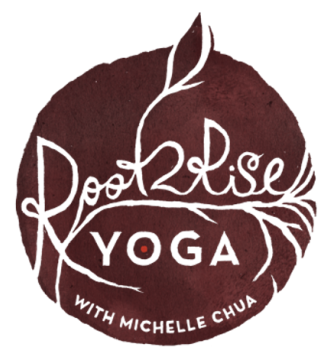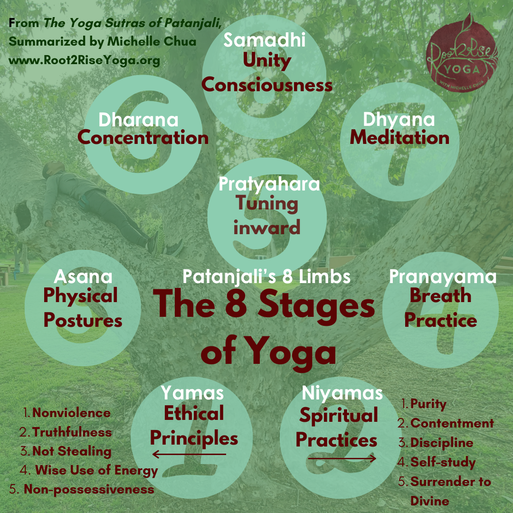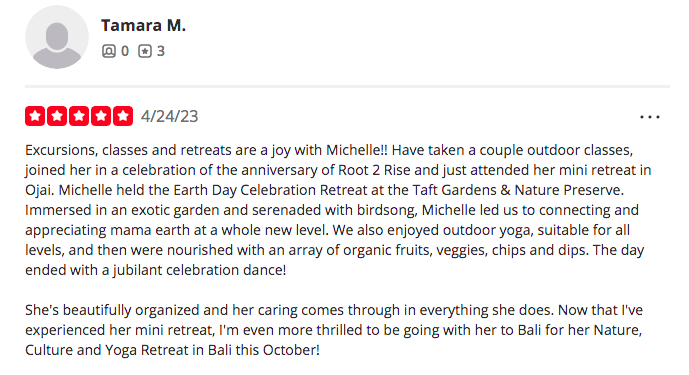Morning 21 Q&A
Here are some questions that arose from our Zoom check-in that you might find helpful to have clarified:
- What if I miss a day? The classes are planned sequentially and built upon each other. If you miss a day, practice the video of the day you missed before moving forward. Also, I'll keep links to the previous videos on our access page throughout the 21 days, and you'll now have access to all 21 videos for another 21 days after June 21st.
- What if I don't have time to practice all 21 minutes of a video that morning? Practice later in the day when you have 21 minutes free. Or, if you really need, fast forward to the last 5-10 minutes for the meditation, to at least have that centering practice.
- How are the classes themed? the first 7 days simply break down the first 2 Limbs of the 8 Limbs of Yoga, according to the Yoga Sutras of Patanjali. Below is a simplified explanation of the 8 Limbs so you can see where the meditation practice (Limbs 5-8), breathwork (Limb 4) and physical postures (Limb 3) fit in.
The second 7 days highlight the 7 main energy centers, known in yoga philosophy as the chakras. The last 7 days discusses the 8 Attitudes of Mindfulness, as identified by Jon Kabbat-Zinn, that promote inner and outer peace.
4. How intense will the yoga postures become? Mindful that you are generally practicing these poses when you first rise from bed and the physical practice is at most 12 minutes long, these poses are generally mild to moderate. Please practice at the level of intensity or depth that feels right for you.
5. How is time allotted for physical yoga, breath work and meditation? In the first 7 days, physical is 12 minutes, breath work is 3 and mediation is 5. In the second 7 days, physical is 10, breath work is 3 and meditation is 7. In the last 7 days, physical is 7, breath work is 3 and meditation is 10. The intention is to warm up towards a longer ability to formally meditate.
6. How can I learn to tailor my own morning yoga after these 21 days? In each YouTube video, expand the caption or description below. There, I list the day's yoga philosophy or mindfulness theme and the main yoga poses, breath work and meditation approach to help develop it. Feel free to take notes or journal about how you feel with the different practices. Use these 21 guided practices to explore and experiment with what you resonate with. At the end of the 21 days, you can refer back to your reflections and choose to similarly sequence a practice within the timeframe (5-30 minutes) that works best for you.
7. Any encouraging words to help me stay on track each day? Ultimately, you might view these 21 days as simply yet potently sharpening your willpower strength to get up each morning and move and focus with intention, from the start. Make it a habit to show up, even if you can't do all 21 minutes that day. But if you really feel your WHY, what you're even doing this for, let that inspire you. 21 minutes of such valuable time-tested science-backed practices is a lot of value in such an economical bit of time! It can be easy to get lost on the internet scrolling for 21 minutes, so why not make the first 21 minutes of your day have uplifting and grounding purpose for your life in the long run? Try going for it with an attitude of open curiosity to just see what happens. But you won't know unless you try it with integrity.
8. How can you yoga contribute to overall fitness, even though it doesn't necessarily provide an aerobic workout? Specific physical yoga postures, such as plank pose, boat pose, chair pose and chaturanga dandasana, when held for several breaths with alignment integrity, can increase muscle strength and endurance. Some postures, like bridge pose, forward folds and hip-openers, promote flexibility, which contribute to agility. Breath work, such as Ujayi pranayama, cultivate focus and regulate the nervous system during strenuous activities. Other breath work, like Breath of Fire and Bellow's Breath, help energize the lungs, contributing to respiratory health, and help prime your lungs for aerobic activities like climbing stairs, running, hiking or playing basketball. Habitual meditation practice benefits your ability to see the bigger picture of an event and direct your mental and physical energy to one activity with heightened focus. Such skills promote effectiveness in whatever fitness activity you're engaged in. Personally, as a regular trail runner, daily yoga has improved my attitude, mental stamina, self-trust, and ability to rebalance my energy skillfully to run joyfully and with more ease on challenging hilly terrains. Lastly, yoga is also a discipline and practice of mindfulness. These help regulate healthy mindful eating and other lifestyle choices that affect overall fitness in alignment to optimal well being.
4. How intense will the yoga postures become? Mindful that you are generally practicing these poses when you first rise from bed and the physical practice is at most 12 minutes long, these poses are generally mild to moderate. Please practice at the level of intensity or depth that feels right for you.
5. How is time allotted for physical yoga, breath work and meditation? In the first 7 days, physical is 12 minutes, breath work is 3 and mediation is 5. In the second 7 days, physical is 10, breath work is 3 and meditation is 7. In the last 7 days, physical is 7, breath work is 3 and meditation is 10. The intention is to warm up towards a longer ability to formally meditate.
6. How can I learn to tailor my own morning yoga after these 21 days? In each YouTube video, expand the caption or description below. There, I list the day's yoga philosophy or mindfulness theme and the main yoga poses, breath work and meditation approach to help develop it. Feel free to take notes or journal about how you feel with the different practices. Use these 21 guided practices to explore and experiment with what you resonate with. At the end of the 21 days, you can refer back to your reflections and choose to similarly sequence a practice within the timeframe (5-30 minutes) that works best for you.
7. Any encouraging words to help me stay on track each day? Ultimately, you might view these 21 days as simply yet potently sharpening your willpower strength to get up each morning and move and focus with intention, from the start. Make it a habit to show up, even if you can't do all 21 minutes that day. But if you really feel your WHY, what you're even doing this for, let that inspire you. 21 minutes of such valuable time-tested science-backed practices is a lot of value in such an economical bit of time! It can be easy to get lost on the internet scrolling for 21 minutes, so why not make the first 21 minutes of your day have uplifting and grounding purpose for your life in the long run? Try going for it with an attitude of open curiosity to just see what happens. But you won't know unless you try it with integrity.
8. How can you yoga contribute to overall fitness, even though it doesn't necessarily provide an aerobic workout? Specific physical yoga postures, such as plank pose, boat pose, chair pose and chaturanga dandasana, when held for several breaths with alignment integrity, can increase muscle strength and endurance. Some postures, like bridge pose, forward folds and hip-openers, promote flexibility, which contribute to agility. Breath work, such as Ujayi pranayama, cultivate focus and regulate the nervous system during strenuous activities. Other breath work, like Breath of Fire and Bellow's Breath, help energize the lungs, contributing to respiratory health, and help prime your lungs for aerobic activities like climbing stairs, running, hiking or playing basketball. Habitual meditation practice benefits your ability to see the bigger picture of an event and direct your mental and physical energy to one activity with heightened focus. Such skills promote effectiveness in whatever fitness activity you're engaged in. Personally, as a regular trail runner, daily yoga has improved my attitude, mental stamina, self-trust, and ability to rebalance my energy skillfully to run joyfully and with more ease on challenging hilly terrains. Lastly, yoga is also a discipline and practice of mindfulness. These help regulate healthy mindful eating and other lifestyle choices that affect overall fitness in alignment to optimal well being.



